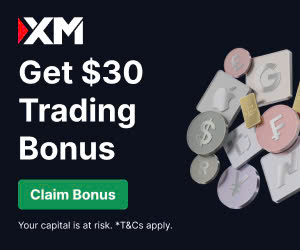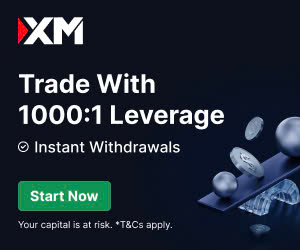
9 minute read
XM vs Pocketion: A Comprehensive Comparison
In the dynamic world of online trading, choosing the right platform can significantly impact your trading success. Two popular platforms, XM vs Pocket Option, have garnered attention for their unique offerings. This comprehensive comparison delves into their features, pros, cons, and suitability for different types of traders. Whether you're a beginner or an experienced trader, this guide will help you decide which platform aligns with your goals.

💥 Trade with XM now: Open An Account or Visit Brokers 🏆
Introduction to XM vs Pocket Option
XM is a globally recognized forex and CFD broker, established in 2009. With over 10 million clients across 190 countries, XM is regulated by top-tier authorities like the Cyprus Securities and Exchange Commission (CySEC), the Australian Securities and Investments Commission (ASIC), and the Financial Services Authority (FSA). Known for its low spreads, diverse account types, and robust educational resources, XM caters to traders of all levels.
Pocket Option, launched in 2017, is a binary options and forex trading platform. It appeals to traders seeking high-risk, high-reward opportunities with a user-friendly interface. Regulated by the International Financial Market Relations Regulation Center (IFMRRC), Pocket Option is popular for its fast-paced trading environment and diverse asset offerings, including cryptocurrencies and stocks.
This article compares XM vs Pocket Option across key factors such as regulation, trading instruments, fees, platforms, account types, and more, ensuring you have all the information to make an informed choice.
1. Regulation and Safety
XM: XM’s credibility is bolstered by its regulation from multiple reputable bodies, including CySEC, ASIC, and FSA. These regulators enforce strict standards, ensuring client funds are protected through segregated accounts and negative balance protection. XM’s transparency and long-standing reputation make it a trusted choice for traders prioritizing safety.
Pocket Option: Pocket Option is regulated by the IFMRRC, a less stringent authority compared to CySEC or ASIC. While it offers client fund protection, the regulatory framework is not as robust, which may concern traders seeking maximum security. However, Pocket Option has built a loyal user base, with many praising its reliability for binary options trading.
Verdict: XM has a clear edge in regulation and safety due to its oversight by top-tier authorities, making it ideal for traders who prioritize security. Pocket Option suits those comfortable with a less regulated environment in exchange for flexibility.
2. Trading Instruments
XM: XM offers over 1,000 tradable instruments, including:
· Forex: 55+ currency pairs, including majors, minors, and exotics.
· CFDs: Stocks, indices, commodities, metals, and energies.
· Equities: Shares from global markets.
This extensive range makes XM suitable for diversified trading strategies.
Pocket Option: Pocket Option provides a wide variety of assets, including:
· Binary Options: Forex pairs, stocks, cryptocurrencies, and commodities.
· Forex and CFDs: Over 100 assets, including currency pairs and indices.
· Cryptocurrencies: Bitcoin, Ethereum, and more.
Pocket Option’s focus on binary options appeals to traders seeking quick returns, while its forex and CFD offerings cater to traditional traders.
Verdict: XM offers a broader range of instruments, ideal for diversified portfolios. Pocket Option excels in binary options and crypto trading, catering to high-risk traders.
3. Fees and Spreads
XM: XM is known for its competitive pricing:
· Spreads: Start from 0.6 pips on the Ultra-Low Spread Account.
· Commissions: Zero on Standard and Micro Accounts; $3.5 per lot on Ultra-Low Accounts.
· Non-Trading Fees: No withdrawal or inactivity fees for most payment methods.
XM’s transparent fee structure and low spreads make it cost-effective, especially for forex traders.
Pocket Option: Pocket Option’s fee structure is simpler:
· Spreads: Not explicitly listed, as binary options focus on payouts rather than spreads.
· Commissions: No commissions on trades.
· Payouts: Up to 96% on successful binary options trades.
· Non-Trading Fees: Minimal withdrawal fees, depending on the payment method.
Pocket Option’s high payout potential is attractive, but the lack of spread transparency may confuse traditional traders.
Verdict: XM offers lower and more transparent fees for forex and CFD trading. Pocket Option is better for binary options traders seeking high payouts.
4. Trading Platforms
XM: XM supports the industry-standard MetaTrader 4 (MT4) and MetaTrader 5 (MT5) platforms, available on:
· Desktop (Windows, Mac)
· Mobile (iOS, Android)
· WebTrader
These platforms offer advanced charting, automated trading via Expert Advisors (EAs), and customizable interfaces, making them ideal for technical traders.
Pocket Option: Pocket Option provides a proprietary web-based platform, also available on:
· Mobile (iOS, Android)
· Desktop (via browser)
The platform is intuitive, with features like social trading, signals, and customizable indicators. However, it lacks the depth of MT4/MT5 for advanced analysis.
Verdict: XM’s MT4/MT5 platforms are superior for technical traders. Pocket Option’s platform is user-friendly but better suited for binary options and casual traders.
5. Account Types
XM:
· Micro Account: Ideal for beginners, with a $5 minimum deposit and micro-lot trading.
· Standard Account: Suits most traders, with a $5 minimum deposit and standard lot sizes.
· Ultra-Low Spread Account: For experienced traders, with a $50 minimum deposit and spreads from 0.6 pips.
· Shares Account: For stock trading, with a $10,000 minimum deposit.
XM’s low entry barriers make it accessible to all traders.
Pocket Option:
· Demo Account: Free, with virtual funds for practice.
· Real Account: Starts with a $10 minimum deposit, offering access to all features.
· VIP Accounts: Higher deposits unlock bonuses and higher payouts.
Pocket Option’s low minimum deposit is beginner-friendly, but its account structure is less varied.
Verdict: XM offers more diverse account types, catering to different trading styles. Pocket Option’s simplicity suits beginners and binary options traders.

💥 Trade with XM now: Open An Account or Visit Brokers 🏆
6. Leverage and Margin
XM: XM provides flexible leverage up to 1:1000, depending on the account type and region. This high leverage allows traders to maximize positions but increases risk. Margin requirements are clearly outlined, with stop-out levels at 20%.
Pocket Option: Pocket Option offers leverage up to 1:500 for forex and CFD trading. Binary options do not involve leverage, as trades are based on fixed payouts. Margin requirements are less emphasized due to the platform’s focus on binary options.
Verdict: XM’s higher leverage is advantageous for forex and CFD traders, while Pocket Option’s structure suits binary options trading.
7. Educational Resources and Support
XM: XM excels in education, offering:
· Webinars, video tutorials, and market analysis.
· Daily trading signals and research tools.
· A dedicated education center for beginners.
Customer support is available 24/5 via live chat, email, and phone in multiple languages.
Pocket Option: Pocket Option provides:
· Basic tutorials and trading guides.
· Social trading features to follow successful traders.
· Market analysis and signals.
Support is available 24/7 via live chat and email, but the resources are less comprehensive than XM’s.
Verdict: XM’s extensive educational resources and support make it ideal for beginners. Pocket Option’s offerings are sufficient but less robust.
8. Deposits and Withdrawals
XM: XM supports over 20 payment methods, including:
· Credit/debit cards
· Bank transfers
· E-wallets (Skrill, Neteller)
Deposits are instant, and withdrawals are processed within 24 hours, with no fees for most methods.
Pocket Option: Pocket Option offers:
· Credit/debit cards
· Cryptocurrencies (Bitcoin, Ethereum)
· E-wallets
Deposits are instant, and withdrawals typically take 1-3 days, with minimal fees for certain methods.
Verdict: Both platforms offer flexible payment options, but XM’s faster withdrawals and no-fee policy give it a slight edge.
9. Bonuses and Promotions
XM: XM offers various promotions, such as:
· Welcome bonus (up to $5,000, subject to terms).
· Loyalty program with rewards for active traders.
· Deposit bonuses for specific regions.
These bonuses are regulated and come with clear conditions.
Pocket Option: Pocket Option provides:
· Deposit bonuses (up to 50% on certain deposits).
· Cashback and risk-free trades.
· Tournaments with cash prizes.
Pocket Option’s bonuses are attractive for binary options traders but may have stricter withdrawal conditions.
Verdict: Both platforms offer competitive bonuses, but XM’s regulated promotions are more transparent.
10. Pros and Cons
XM Pros:
· Regulated by top-tier authorities.
· Low spreads and transparent fees.
· Wide range of trading instruments.
· Industry-standard MT4/MT5 platforms.
· Extensive educational resources.
XM Cons:
· Higher minimum deposit for Shares Account.
· Limited cryptocurrency offerings.
Pocket Option Pros:
· Low minimum deposit ($10).
· High payouts for binary options.
· User-friendly platform.
· Diverse asset classes, including cryptocurrencies.
· Social trading features.
Pocket Option Cons:
· Less stringent regulation.
· Limited educational resources.
· Proprietary platform lacks MT4/MT5 depth.
Which Platform Should You Choose?
The choice between XM vs Pocket Option depends on your trading goals, experience level, and risk tolerance:
· Choose XM if:
· You prioritize safety and regulation.
· You trade forex, CFDs, or stocks with a diversified portfolio.
· You value low spreads, MT4/MT5 platforms, and educational support.
· You’re a beginner or intermediate trader seeking long-term growth.
· Choose Pocket Option if:
· You prefer high-risk, high-reward binary options trading.
· You want a low minimum deposit and quick trade execution.
· You trade cryptocurrencies or enjoy social trading.
· You’re comfortable with a less regulated platform.
For a balanced approach, consider using both platforms: XM for forex and CFD trading and Pocket Option for binary options or crypto-focused strategies.
Tips to Maximize Your Trading Experience
· Start with a Demo Account: Both XM vs Pocket Option offer demo accounts. Practice your strategies risk-free to build confidence.
· Stay Informed: Use XM’s market analysis or Pocket Option’s signals to stay updated on trends.
· Manage Risk: Set stop-loss orders on XM or use Pocket Option’s risk-free trades to minimize losses.
· Leverage Education: XM’s webinars and tutorials can enhance your skills, while Pocket Option’s social trading lets you learn from others.
· Diversify: Trade multiple instruments on XM or explore Pocket Option’s crypto offerings to spread risk.
Conclusion
XM vs Pocket Option cater to different trading styles, making them complementary rather than direct competitors. XM is the go-to choice for regulated, diversified trading with low costs and robust support. Pocket Option shines in binary options and crypto trading, offering high payouts and a beginner-friendly interface.
By understanding your priorities—whether it’s safety, asset variety, or quick returns—you can choose the platform that best suits your needs.
💥 Note: To enjoy the benefits of the partner code, such as trading fee rebates, you need to register with XM through this link: Open An Account or Visit Brokers 🏆
Read more:

